Toyota Fortuner review: HiLux-based SUV misses the mark
The Toyota HiLux has been the best selling vehicle for the past few years, but not many people would have heard of the SUV version.
What’s gone wrong with the Toyota Fortuner? It’s a seven-seater 4WD wagon, the little brother of the 200 Series LandCruiser and Prado and the cousin of HiLux, which sell by the boatload, largely because of the blue-chip Toyota badge. Fortuner should at least be on the podium in its class, surely?
Nope. It languishes in 12th place. Prado, in pole position, outsells it by nearly eight-to-one and its direct rivals, Mitsubishi’s Pajero Sport, the Isuzu MU-X and Ford Everest each won more than twice as many customers in 2020.
Clearly, Fortuner has an “Oh, not a feeling” problem. What is it?
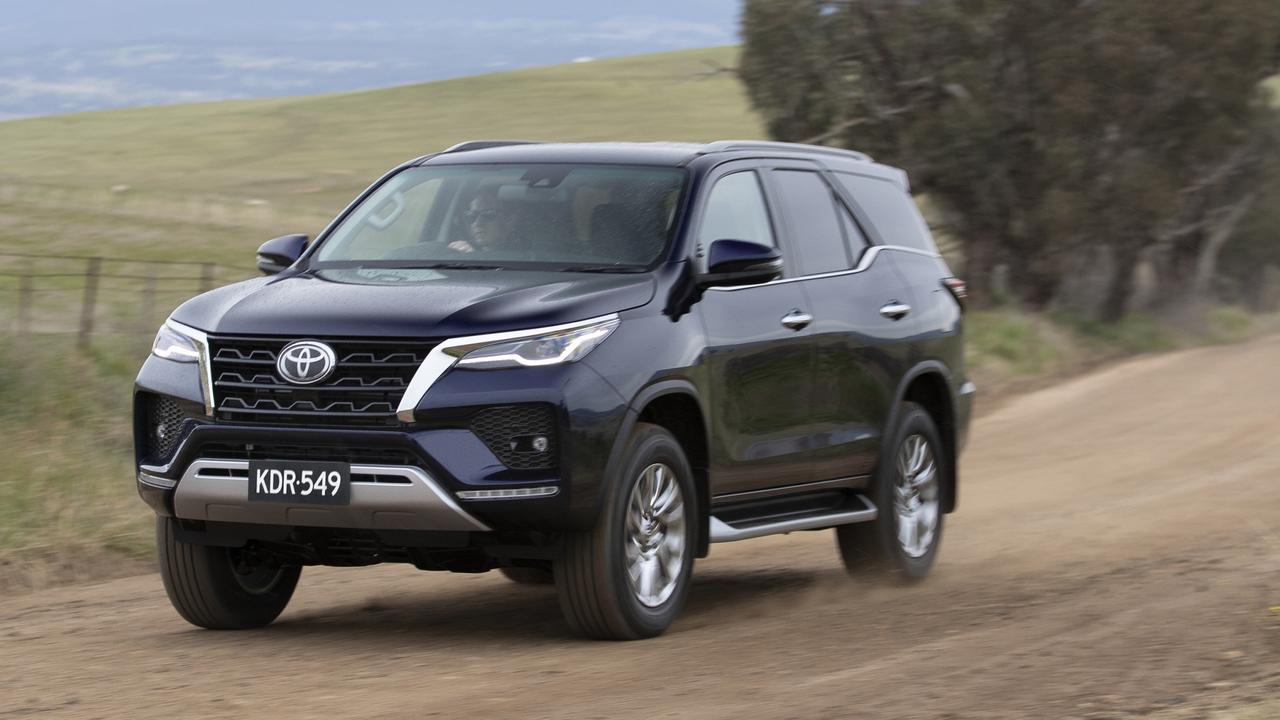
VALUE
In late 2020 Fortuner received the same upgrade to its 2.8-litre turbo diesel and six-speed auto as the HiLux and Prado. Peak power increased 20kW to 150kW and torque by a hefty 50Nm to 500Nm. So it now shares class-leading outputs with Ford’s 2.0-litre turbo Everest.
Maximum claimed towing weight increases 300kg to 3100kg, thanks to more efficient engine cooling and transmission operation. At Fortuner’s gross vehicle mass of 2800kg, (including towball download), its legal maximum trailer weight is 2750kg. Prado will legally pull its claimed 3000kg maximum at its 2990kg GVM.
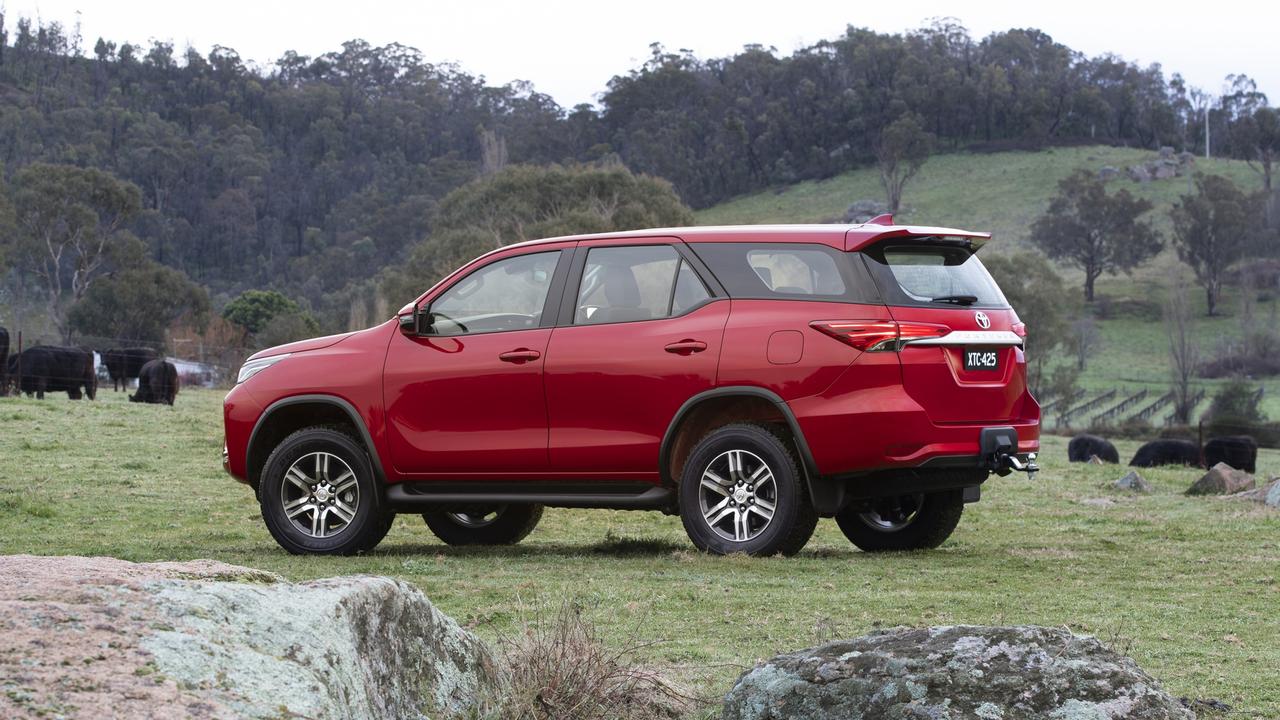
Toyota also claims greatly improved fuel efficiency — more than 17 per cent around town and 11.6 per cent overall. We couldn’t achieve the official numbers. Our Fortuner used 10-12L/100km in town. On the highway, it will do 8.0L/100km, getting you near enough to 1000km from its 80-litre tank. Prado’s tank is 150 litres.
In the cabin, a larger infotainment screen features button and touch interfaces for main menus, excellent voice control and Apple CarPlay/Android Auto connectivity. A digital speedo is also added.
Toyota discounted Fortuner by more than $5000 in late 2017 to fire up sales; they’ve taken $3000-$4000 of that back for the 2021 update.
The base Fortuner GX is $49,080 plus on road costs. That’s still more than $10,500 cheaper than Prado GX — which has the same engine and transmission — and $8010 less than the 2.0-litre Everest Trend.
Fortuner GXL costs $54,350 and Crusade, tested here, is $61,410.
Servicing is required every six months, which is ridiculous.
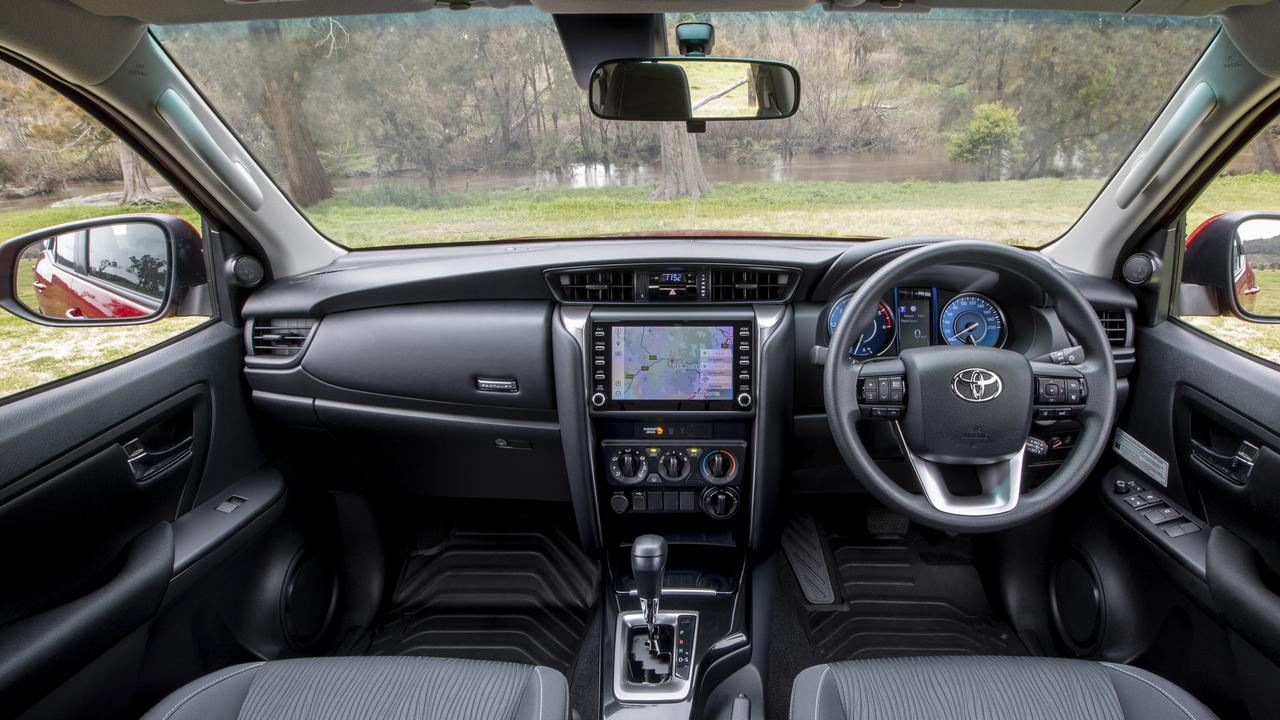
COMFORT
Despite niceties such as leather-faced seats, JBL audio and (the world’s slowest) power tailgate, Crusade feels more like $30K than $60K in the cabin — industrial and impoverished, with hard, shiny plastics, (very) fake tree trim, an unsupportive driver’s seat, one only USB/12 volt outlet up front and no wireless phone charging.
A spacious, elevated middle row, split 60/40, includes 12-volt and 220-volt outlets (no USB), roof vents and low window sills, so kids will have a good view of the world.
Both sides tumble forward for easy access to two kid-sized individual back seats that fold up against each side of the cargo bay when not in use. Setting up or stowing them is fiddly and strenuous compared with rivals’ back stalls that fold into the floor. It also compromises carrying capacity.
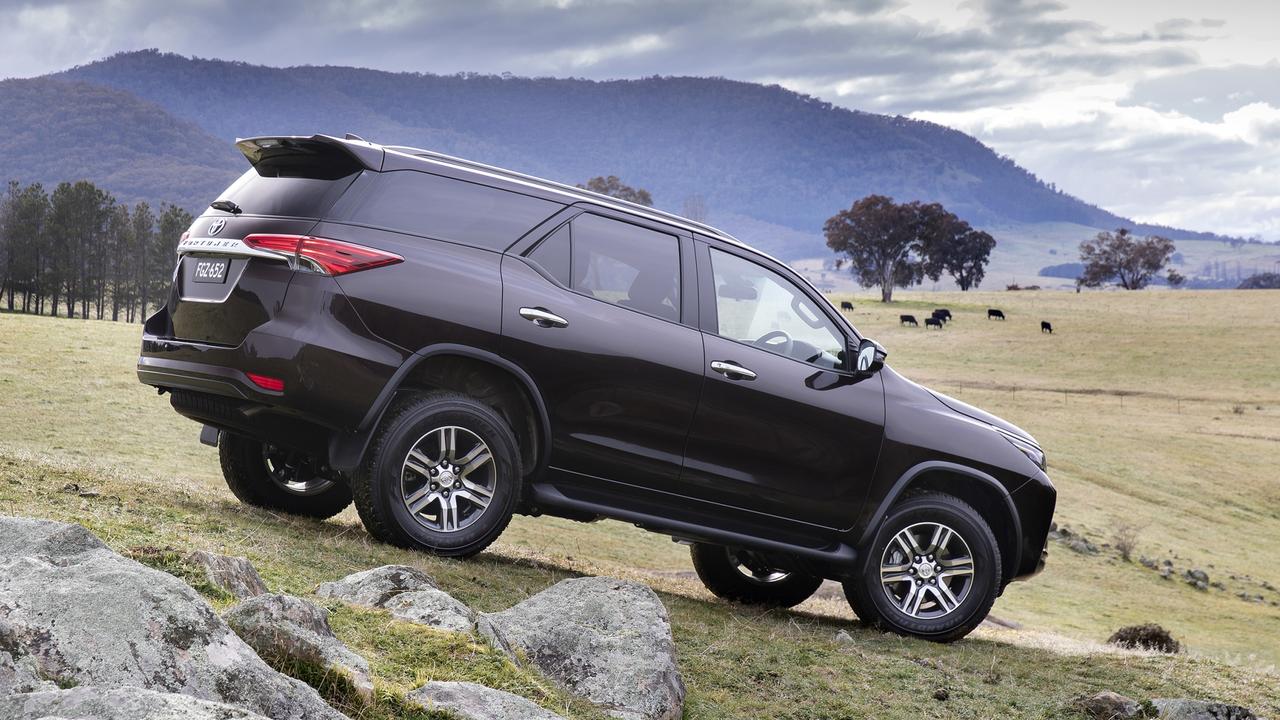
SAFETY
Underdone at the price, Crusade misses out on blind-spot monitoring, rear cross-traffic alert and surround cameras, all standard on Pajero Sport Exceed.
DRIVING
As with Prado and HiLux, Fortuner drives like an old-school 4WD. It feels heavy, ponderous and occasionally nervous in bumpy corners. Over-assisted steering wanders disconcertingly at highway speeds and is prone to mild shake on rough roads. Wooden brakes lack power.
If you’re not going to use Fortuner’s considerable off-road or towing capabilities, you’re making a lot of unnecessary on-road performance, handling, comfort, safety and refinement compromises compared with a seven-seater SUV such as Kia’s Sorento or Hyundai’s Santa Fe.
That said, Fortuner is considerably less barge-like in corners than the Prado, because it’s lighter, lower and has better-controlled suspension. This also translates to a firm and reasonably absorbent, though fussy ride.
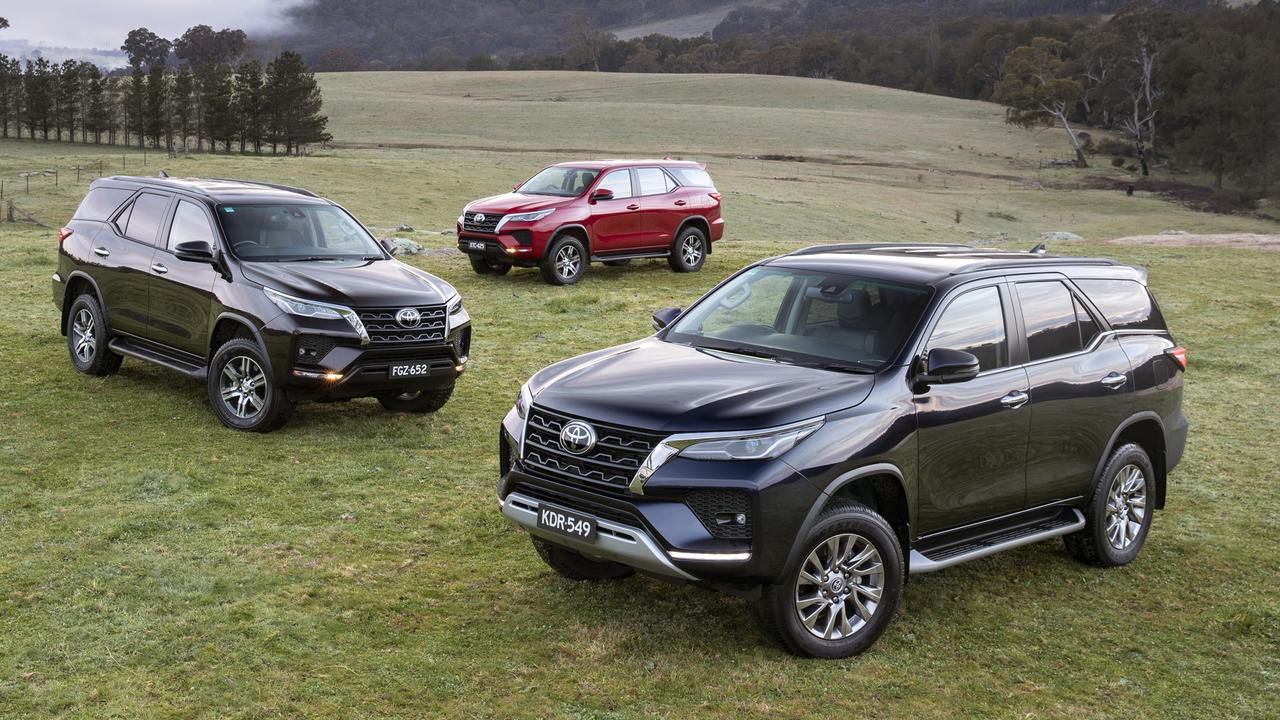
The 2.8 is a good thing. It’s much smoother here than in the HiLux tested a few months ago, with the extra 50Nm of grunt particularly noticeable where it counts, from idle to 2500rpm. The automatic shifts smoothly and decisively.
Off-road, Fortuner does the business easily, as you would expect. It features proper low range gearing — albeit with a loud whine from the transfer case — 216mm of ground clearance, 700mm wading depth and a locking rear differential. The 2.8’s strong bottom end is amplified in low range, where it will idle up, down or over just about anything, displaying excellent throttle modulation and smooth, timely gear changes.
HEART SAYS
I want a reliable 4WD wagon to go travelling, and Toyota is a safe, dependable choice.
HEAD SAYS
Sure, it’s a poor man’s LandCruiser, but I don’t need a huge wagon and it’s still got pure-bred Toyota 4WD genetics.
VERDICT 3/5
The base model Fortuner GX is good value for a tough, no frills Toyota 4WD. Crusade, though, is overpriced, underequipped and an ordinary drive compared with rivals.
ALTERNATIVES
Ford Everest Trend from $57,090
This is the base 150kW 2.0-litre turbo/10 speed auto Everest 4WD, but it’s comparably equipped to the top-spec Fortuner Crusade. More comfortable and better handling on road.
Mitsubishi Pajero Sport Exceed $57,690
Top-spec Pajero Sport 4WD runs a 133kW 2.4-litre engine through an eight-speed auto. Stylish, comfortable and reliable, loaded with luxury and best in class driver-assist safety tech.
TOYOTA FORTUNER CRUSADE VITALS
Price: $61,410
Warranty/servicing: 5 yr w’ty; $1500 for 3yrs/60,000km
Engine: 2.8-litre 4-cyl turbodiesel, 150kW/500Nm
Safety: 5 stars, 7 airbags, auto emergency braking, adaptive cruise, lane departure warning, lane-keep assist
Thirst: 7.6L/100km
Spare: Full-size
Boot: 716L (5-seater mode)



